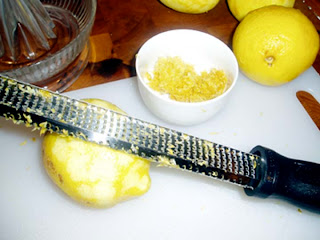An Algarvan take on the chilled summer soup, this one is without the almonds and with orange. Gaspacho (Portuguese spelling) was probably developed throughout the northwest Mediterranean during the era of the Moors (711 - 1250) and wouldn't have begun to include tomatoes until after the 16th century. Before tomatoes, gaspacho was made with stale bread, garlic, vinegar, olive oil, almonds, water, and salt.
The Algarve, and its eastern counterpart, Andalusia -- both derivations of Arab terms -- are rich in almonds, oranges, garlic (and, more recently, tomatoes), thanks to the Moors' introduction of irrigation in the 8th century. This area, al-Gharb ("the west") and al-Andalus (etymology debated), referred to its western position in the Moors' world. The soup was part of this world. The international border and spelling distinctions were added later.
A pretty soup and lightly sweet, this version comes in four parts: the soup base, a dressing, vegetable accompaniments, and various garnishes.
For the soup
Yields 8 servings, about 4 ounces each
5 oz white bread, without crust, torn into chunks
40 oz yellow tomatoes, cored and halved pole-to-pole
2 oz champagne vinegar
4 oz Navel orange juice, freshly squeezed
16 oz cucumber, peeled and seeded
16 oz yellow bell pepper, seeded
3 oz sweet onion, chopped
1 teaspoon garlic, minced
1 teaspoon orange zest
3 oz peppery olive oil
1/2 teaspoon flor de sal
1. Tear bread into chunks and place in medium bowl.
2. Seed tomatoes over sieve set over 16-oz measuring cup. Press seeds to extract juice. To tomato juice, add orange juice and vinegar. Add water to bring total to 16 ounces. Mix and pour over bread and set aside for 10 minutes or until evenly wet throughout.
3. Cut enough tomatoes into 1/4-inch dice to equal about 2 cups. Place in refrigerator bowl and set aside. Chop remaining tomatoes coarsely and place in bowl of food processor. Cut cucumber into 1/4-inch dice to equal 1 cup. Place in small refrigerator bowl. Coarsely chop remainder of cucumber and add to food processor. Cut bell pepper into 1/4 inch dice to equal 1 cup. Place in small refrigerator bowl. Coarsely chop remainder of pepper and add to food processor. Cover diced vegetables and chill.
4. Meanwhile, add onion, garlic, orange zest to vegetables in food processor. With processor running, slowly add olive oil and blend until smooth. Strain into clean, medium bowl, pressing on solids to extract as much juice as possible. Rinse food processor blade and bowl and return vegetable juices to processor. Pour soaked bread with juices into food processor. Blend until smooth. Place bread-vegetable mixture in one quart glass storage container and chill.
5. The gaspacho needs to rest for at least 6 hours. Can be made 24 hours before serving.
For the dressing
Yields 12 ounces
5 oz cilantro leaves (stems discarded), chopped (about 5 bunches)
1.5 oz scallions, chopped
1 Tablespoon garlic, minced
1/2 teaspoon flor de sal
6 oz olive oil, green and peppery
1 oz ice water
1. Find 8 or more perfect whole cilantro leaves and set aside for garnish. Place in a folded sheet of paper towel and store in sealed plastic bag. Chill until serving.
2. Combine produce and salt in food processor and blend. When nearly smooth and with processor running, slowly add oil.
3. Pour dressing into sieve set over bowl. Press solids to extract as much juice as possible. Discard solids. Whisk water into juice.
4. Cover and chill. Keeps 3 days. Before using, whisk again and taste for seasoning.
Garnishes, passed individually at table
Diced vegetables in separate bowls
12 oz avocado, diced
1.5 oz scallion, sliced very thinly
Whole cilantro leaves
Flor de sal
To serve, ladle soup into chilled bowls. Add dollop of cilantro dressing. As is traditional, bowls of individual, diced vegetables and garnishes are passed separately.
This posting and recipe is copyrighted by Marshall Brewer, 2007.
http://marshallbrewer.blogspot.com/







































